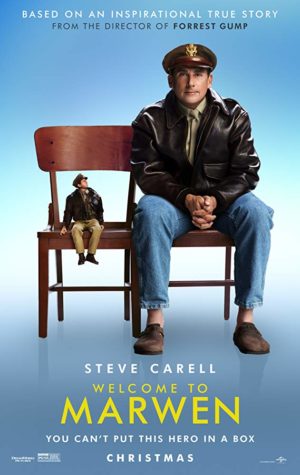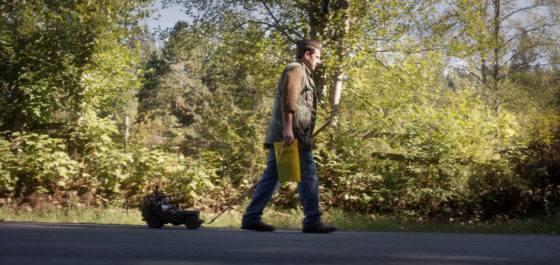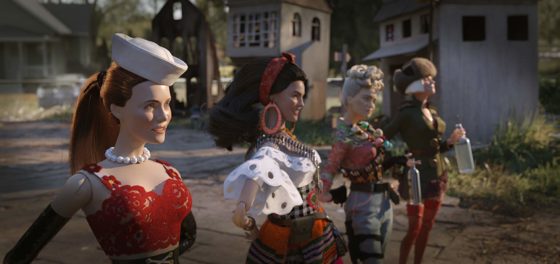
[Rating: Minor Rock Fist Down] 
Each person who deals with traumatic events in their lives, copes differently with the aftermath — piecing together how something so extreme could happen to them, and what they need to do to keep the bad memories at bay so that further issues won’t arise.
In 2000, artist Mark Hogancamp experienced a life threatening assault. In the aftermath, he created a miniature town of dolls set in World War II Belgium, and named it Marwencol. The town and its miniature inhabitants would be preserved through photos as a way for Hogancamp to cope with the pain and memories of his fateful night, and help build back a memory completely lost. His story is documented in the 2010 documentary Marwencol. Now, audiences are getting a Hollywood adaptation of the story, Welcome to Marwen directed by veteran director Robert Zemeckis and starring Steve Carell as Hogancamp.
Welcome to Marwen is a difficult film to grasp. In this time of awards season it wants to push its redundant narrative down any sympathetic throat and yet at the same time, wants to tell a story of grief and the aftermath that unfortunately is stalled in part because of its very one-note characters. Though this is a heartfelt film, it begs you to feel sorry for everything happening, rather than letting everything naturally fall into place.

Alongside Carell are the various women in his life who have also inspired the Marwen dolls in the film. Merritt Wever is Roberta, a friend and owner of a toy shop that provides Mark with his dolls and materials for the town and who watches after him and tries to make him open up more to her. Janelle Monae is Julie, his physical rehab therapist who tells him that embracing his pain will help fight his pain. Eiza Gonzalez is co-worker who embraces Marks stories. Gwendoline Christie is Ana, Mark’s caretaker and a staunch Russian who warns him not to become too dependent on his medication. Leslie Zemeckis is Suzette, Mark’s favorite “adult film” actress who inspires a doll, and finally Leslie Mann is Nicol, a new neighbor who Mark immediately finds both attraction and solace in and who inspires his most important doll, his alter ego Captain Hoagie to find love without consequences.
Diane Kruger voices Deja Thoris, the villain of Marwen and from what this reviewer understood, the chip on Mark’s shoulder, the pain of his lost memories, and the dependency on the drugs that keep him leveled.
All the female characters of both Mark’s life and Marwen help him bring back what was lost. It helps him communicate better with life as all the “real life” people accept that fact he brings around his dolls as a coping mechanism. The dolls help Captain Hoagie fight off the bad men, the Nazis in particular that plague Hoagie and Mark, a representation of the men who attacked Mark. Mark understands that he is different and because of his differences (which won’t be spoiled because it is a large part of why he was attacked) he’s looked differently upon by others who may not always understand, but push to accept.
I myself sympathized one hundred and ten percent with Mark, but when this same theme is presented five different ways and each way feels overly saccharine, you get tired. There’s a juxtaposition between the real world and Marwen and they blend together each time Mark has episodes of PTSD, but that feels redundant very quickly. Leslie Mann’s character who befriends Mark is terribly underwritten. We get a glimpse about her past life and nothing is done about it. In fact, most of the women in the story are more lively in the animated world than they are in the real world. Even further, can nobody in the town help Mark remember who he was or what his life was all about? Who is this Wendy that Mark constantly refers to? If anything, this is two different movies: one of Mark’s real-life story and casting it aside, the animated portions of this flick. The animated world offers more rewards.

Zemeckis isn’t known for his animation (see: The Polar Express), but hallelujah Welcome to Marwen finally gets it right! These dolls can blink, their eyes tell their emotions and they move with such grace and sass. The most exciting and more interesting portion of the film is the animated world of Marwen, told through motion-capture CGI. Most of the story of Marwen is Hoagie and the women constantly fighting off Nazis (again more of a repetitive in-your-face theme) only to have them return. This battle has no ending in sight. It isn’t until Nicol comes into place that things change for everybody and Hoagie understands why Deja most likely is against him, rather than trying to help him.
The animated sections of the film have some of the better qualities of the picture, especially the cinematography. It’s obviously different between real life and animation, but you feel like you’re watching a real World War II film flying across Belgium into this small town and traveling with these dolls among grass to a world only Mark can see come to life.
In the end, Welcome to Marwen just feels like another inspirational and uplifting Oscar-bait film, the kind Hollywood throws out every Christmas. Last year it was Downsizing, and while these movies’ trailers always look like the films have potential, the real truth is just they want you to feel some sort of artificial emotion. Welcome to Marwen is a fine movie if it was two separate stories, but as one it doesn’t work. Again, the animated sections work as a whole and alongside the real-life story, there’s two movies that would work by themselves. On the bright side, in the end there is a good message about how to handle trauma. It takes time and patience and yet when we can get rid of our dependency on the things that try to hurt us, in the end we can succeed and remember life in the best ways possible as Mark does and has been doing since creating his solace of Marwen.






Comments on this entry are closed.